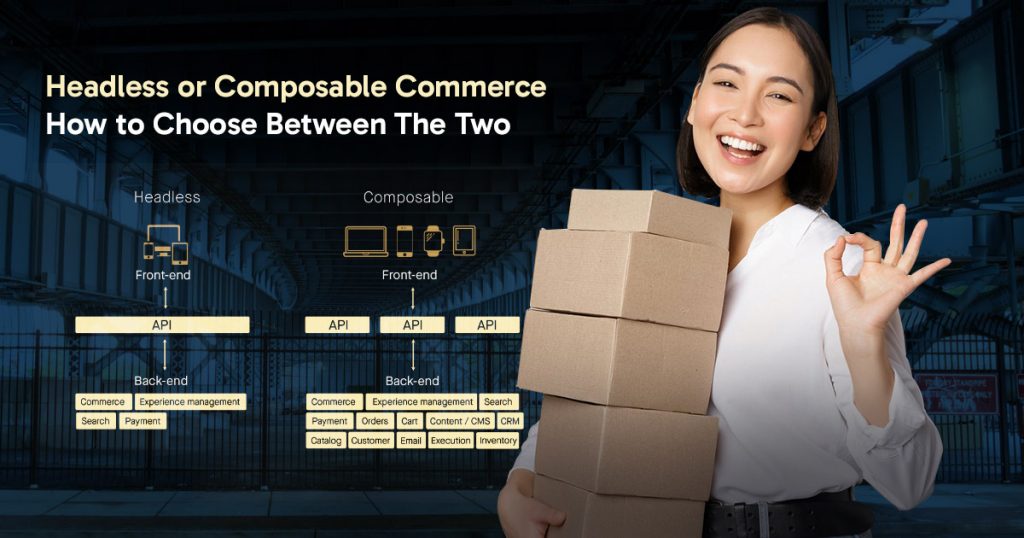E-commerce businesses today need flexibility to meet growing customer expectations. The platforms they choose must keep up with rapid changes. That’s where modern solutions like headless and composable commerce come in. These two approaches offer freedom, customization, and scalability. But how do you choose between them? They both have pros and cons, and you must understand what you’re getting first before deciding.
Headless Commerce Definition
Headless commerce separates the frontend and backend of your ecommerce system. Your team can work on the user experience without changing the backend. This separation makes it easier to design custom shopping experiences for customers.
The “head” refers to the frontend, like your website or app. When it’s removed, or “headless,” you can plug in any frontend you want. This gives developers more control and creative freedom. It also supports omnichannel selling, allowing businesses to deliver consistent experiences across web, mobile, and other channels.
What is Composable Commerce
Composable commerce goes a step further. It builds on headless architecture but allows you to pick and choose the best tech for every function. You’re not tied to a single vendor or suite. Instead, you assemble your platform using APIs, microservices, and cloud-based tools.
Think of it like building with LEGO blocks. You choose the right pieces for your checkout, product search, analytics, and other parts. If one part stops working or isn’t good enough, you can replace it without touching the rest of your system.
How They Stack Up: Headless vs Composable
At first glance, headless and composable seem similar. Both offer flexibility and customization. But their key difference lies in how modular they are.
Headless commerce gives you a flexible frontend but often keeps the backend in one system. You get freedom in presentation, but not always in function. Composable commerce lets you pick each service independently, even the backend ones.
Here’s an example. With headless, you might still rely on one vendor for checkout, product management, and inventory. In composable, you could use different vendors for each of these services and connect them through APIs.
That’s why composable commerce is often called a “best-of-breed” approach. It gives you complete control over every part of your ecommerce stack.
Choosing Based on Business Needs
When deciding between the two, your business goals matter most. Consider the following factors.
1. Flexibility and Customization
If you want a highly customized user experience, both options will help. But composable commerce gives more freedom beyond the frontend. It lets you tailor backend functions too.
For example, if your checkout experience needs special workflows, composable systems let you use a tool that supports that exact need.
2. Time to Market
Headless commerce platforms usually offer faster deployment. If you want to get started quickly, headless might be the better choice. You can keep your existing backend while launching a new frontend experience.
Composable commerce takes more time to build and manage. It requires technical expertise to connect all the different parts. But once it’s up and running, you’ll have greater agility.
3. Developer Resources
Headless systems are easier for most teams to adopt. You’ll need some development skills, but not a full team of specialists.
Composable commerce often needs experienced developers. You’ll be managing multiple services, APIs, and vendors. It offers more freedom, but also demands more technical support.
4. Long-Term Growth
If you expect your business to evolve quickly, composable commerce prepares you for the future. You won’t be locked into one system. As your needs change, you can swap out services without reworking everything.
Headless commerce still offers scalability, but with some limitations. You might need to make compromises depending on your backend setup.
What Big Brands Are Doing
Many large retailers and digital brands now lean toward composable commerce. They want to innovate fast and stay ahead of market trends.
These businesses often have the technical teams needed to manage a composable setup. They also benefit from having full control over every part of their e-commerce operations.
On the other hand, mid-size businesses often choose headless commerce. It offers a strong balance of flexibility and simplicity. It’s a practical step for companies moving away from legacy systems without diving into full modularity.
The Costs Behind the Choice
There’s no simple answer when it comes to cost. Headless commerce usually involves lower upfront costs and simpler vendor contracts. It’s often bundled or offered through platforms you may already use.
Composable commerce can be more expensive at first. You’re paying for several services and may need to hire or train developers. But over time, it can become more cost-effective, especially as you avoid vendor lock-in and gain performance efficiency.
It helps to look at your total cost of ownership over time, not just the starting point.
Integration and Maintenance
With headless commerce, you have fewer moving parts. That means easier integration and lower maintenance costs. The downside is you may have to work around system limitations.
Composable commerce comes with higher complexity. You’re in charge of connecting and maintaining every piece. But the benefit is control. You decide what tools to use and how they work together.
If you value ease of use, headless might be enough. If you need total freedom and don’t mind extra effort, composable fits better.
Pick Your Pieces, Shape Your Future
Think of your e-commerce platform as a foundation for growth. Whether you go with headless or composable, the goal is to support your customers and adapt as they change.
Choose what helps you move faster, serve better, and build smarter. That’s what really matters in today’s digital market.
